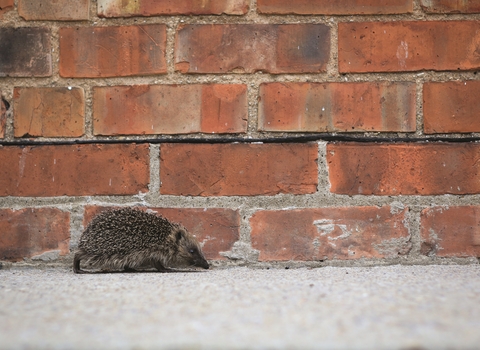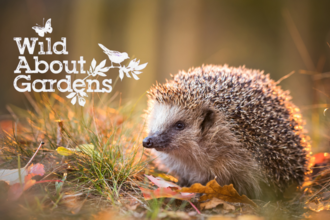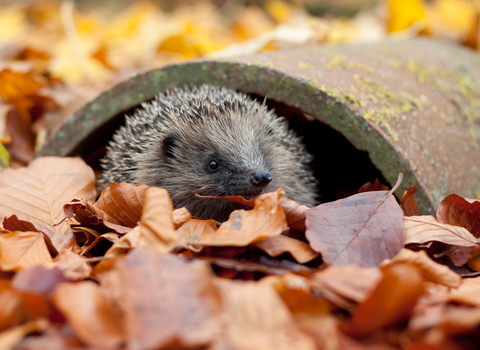Hedgehogs used to be a familiar and well-loved visitor to our gardens, but there's been a startling decline of 95% since the 1950s. On this page you can find out more about these spiky mammals and what you can do to give them a helping hand.
Now on the IUCN Red List for mammals, in 2020 hedgehogs have been classed as vulnerable to extinction. Everyone’s contribution is important to helping these iconic creatures. We need to work together with our neighbours to make small changes that will make a big difference.
By checking bonfires in autumn and building them responsibly, gardening in a wildlife-friendly way and increasing connectivity, we can help them to move around safely and find havens to make their homes.
Do hedgehogs hibernate?
Although many species are less active over winter in the UK, only three enter true hibernation: hazel dormice, our native bats and hedgehogs.
Depending on the weather and their body condition, they usually hibernate from around November through to March or April depending on the weather. Research has shown that they may move nesting sites at least once during this period, so if you spot one out and about it may be that they need food, or they might just be looking for a new spot to nest.
Log and leaf piles are one of their favourite places to nest and hibernate, so please do read the tips below for how to check bonfires for hedgehogs before lighting them.
What do hedgehogs eat and can I feed them?
Hedgehogs eat a variety of insects, molluscs and other invertebrates, often switching from one food type to the other depending on the time of year. Beetles, earthworms and caterpillars make up most of their diet, but you can provide food to support them as they fatten up for hibernation.
You can feed them non-fish based cat food or bird food and water. Do not give them bread and milk as it will make them ill and can even be fatal. Hedgehogs are lactose intolerant, so at best milk will severely upset their stomachs. Bread holds very little nutritional value meaning they’ll fill up on food which will not help them in the long run.
Cat or dog food is a good food to offer, as are some of the ready packaged hedgehog food you can buy in pet stores and supermarkets. Of course, the best food you can provide is the natural snack bar which comes from a hedgehog-friendly garden!
How do I check my bonfire for hedgehogs?
- If you're building a bonfire, build it on the same day that you will light it. The longer it’s left for, the more likely it is that a hedgehog will wander in
- Place chicken wire one metre high at an outward angle all the way around the bottom while you're building
- If you have stored materials for your bonfire outdoors, then move them to a different patch of ground
- Always place the bonfire on open ground – never on a pile of leaves as a hedgehog may be hiding underneath
- Always check the entire bonfire for hedgehogs before lighting it - they tend to hide in the centre and bottom two feet in particular
- When checking, lift parts of the bonfire section by section using a pole or broom - using a fork, spade or rake can injure them so don't use them
- Use a torch to look inside the bonfire and listen for a hissing sound, as this is the noise that hedgehogs make when they are disturbed or distressed
- Always light your bonfire from one corner rather than in the centre in order to give hedgehogs a chance to escape if they need to
If you do find a hedgehog then move slowly and calmly. Pick it up with gardening gloves, along with any nesting material it may have been sitting in, and place it in a cardboard box lined with newspaper. Relocate the box to a safe location that is far from any fires or wait until the bonfire is over and dampen down the fire site with water before releasing the hedgehog under a bush or a log pile.
You can find more tips on what to do if you find an injured hedgehog on our wildlife advice page.
How can I make my garden more hedgehog friendly?
In rural areas, our farmland increasingly lacks the diversity of habitats hedgehogs need and the food they rely on. In towns and cities green spaces are lost to development, paved over or increasingly fragmented. Urban areas and our gardens have the potential for protecting and strengthening existing hedgehog populations - our gardens provide a space for wildlife larger than all the national nature reserves combined!
Almost all gardens, including those in the heart of towns and cities, will receive at least occasional visits from some mammals. The closer you live to a meadow, park, woodland or a space where mammals are often found, the greater the likelihood these animals will make their way into your garden.
This Wild About Gardens booklet is a great resource with plenty of small steps everyone can take together to get to know hedgehogs better and how to make gardens more hedgehog friendly.
Download the free Wild About Gardens hedgehog leaflet
Increase accessibility
Adult hedgehogs travel between 1-2km per night over home ranges as big as 10-20 hectares in size. In suburban areas, this means they range over entire housing estates and neighbourhoods.
Ensure there are gaps at ground level in hedges and fences. This will help wildlife to move from garden to garden. You can find out more by clicking 'How to create a hedgehog hole' below.
Plant native species
Mammals prefer eating native plants and fruits. Plant native trees, plants and shrubs such as hazel, crab-apple, hawthorn, privet, guelder rose, wayfaring tree and spindle.
Some mammals are omnivores or carnivores, so a soil rich in invertebrates is important to feed hedgehogs and the native trees and shrubs will provide insects for bats.
Provide enough water
It is as important for wildlife as it is for us to keep hydrated. Provide a shallow dish of water for thirsty birds, mammals, and even insects. Putting a rock in the centre gives insects a way to dry off if they fall in.
If you'd like to restore or create a wildlife pond, click here. If you're creating a pond, make sure there are shallow areas for hedgehogs to drink from and so they can climb out if they fall in.
A safe shelter
Hedgehogs love the warmth of a compost heap, so while these are a great way to attract them, ensure you check for the heap before using the compost on your garden. Find out more about composting here.
Avoiding using pesticides or too many chemicals
Pesticides are potentially dangerous to hedgehogs and slug pellets are no exception. Hedgehogs may eat the pellets, and they are very likely to eat the poisoned slugs and snails. Hedgehogs are known as gardeners friends because of how they keep garden 'pests' like slugs and snails under control.
Check the area before doing any work
Being aware of dangers such as checking the area before strimming and mowing or lighting a bonfire. This is good practice not only for hedgehogs, but other wildlife too.
Add your sightings of hedgehog highway to the map
If you have seen a hedgehog or have created a hole in your fence for hedgehogs to move around, you can add these to the Big Hedgehog Map.
Hedgehog Street is run by the People's Trust for Endangered Species and the British Hedgehog Preservation Society. The map helps organisations like us to find out where hedgehogs are across the county as well as how they are doing nationwide.
There’s also a useful forum page on their website where you can talk about everything hedgehog, top tips and latest news articles.





